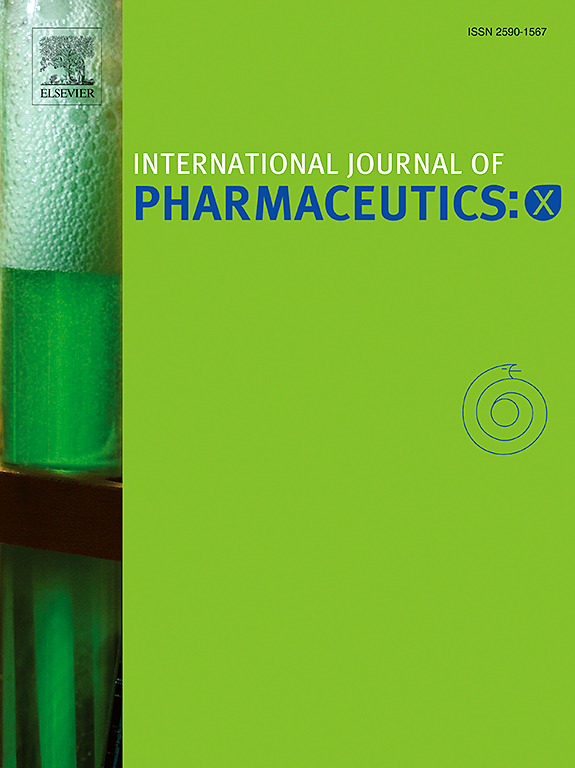Packing and flow performance of binary adhesive mixtures for inhalation of different drug loads and their relationships to aerosolisation
IF 6.4
2区 医学
Q1 PHARMACOLOGY & PHARMACY
引用次数: 0
Abstract
The aim of this study was twofold. First, to examine the mechanical properties (packing and flow) of a series of adhesive mixtures, consisting of two different lactose carriers and varying concentrations of budesonide, using a range of test methods. Second, to investigate if any of the test methods correlate with the dispersibility of the mixtures, i.e. the fine particle fraction and mass median aerodynamic diameter. The mechanical properties assessed included packing, shearing, permeability and compressibility. Dispersion data were generated using an impactor operated at two pressure drops (0.5 and 4 kPa). To explore correlations between the mixture properties, Principal Component Analysis and Pearson correlation were used as statistical tools.
The different test methods yielded different property-drug load relationships, which can be classified into two groups: First, packing density and shearing properties, and second, permeability and compressibility. The methods in the first group produced markedly fluctuating property-drug load relationships, characterised by two distinct waves. This type of property-drug load relationship was similar to that observed in the dispersion experiments, and significant correlations were found between shearing properties and dispersibility. Thus, any correlations between mechanical and dispersion properties depend on the choice of the test method used. The underlying cause of this co-variation is the parallel effect of both the blend architecture and the structure of the adhesion layer on mechanical and dispersion properties.

用于吸入不同药物负荷的二元粘合剂混合物的包装和流动性能及其与雾化的关系
这项研究的目的是双重的。首先,使用一系列测试方法,检查由两种不同的乳糖载体和不同浓度的布地奈德组成的一系列粘合剂混合物的机械性能(包装和流动)。其次,研究是否有任何测试方法与混合物的分散性相关,即细颗粒分数和质量中值气动直径。评估的力学性能包括填料、剪切、渗透性和压缩性。分散数据是通过在两个压降(0.5和4 kPa)下操作的冲击器生成的。为了探讨混合性质之间的相关性,使用主成分分析和Pearson相关作为统计工具。不同的测试方法得出了不同的性能-药物负荷关系,可分为两组:第一组是堆积密度和剪切性能,第二组是渗透性和压缩性。第一组方法产生了明显波动的性质-药物负荷关系,其特征是两种不同的波动。这种性质与药物负荷的关系与分散实验中观察到的相似,剪切性能与分散性能之间存在显著相关性。因此,机械性能和色散性能之间的任何相关性取决于所使用的测试方法的选择。这种共变的根本原因是共混体系结构和粘附层结构对机械和分散性能的平行影响。
本文章由计算机程序翻译,如有差异,请以英文原文为准。
求助全文
约1分钟内获得全文
求助全文
来源期刊

International Journal of Pharmaceutics: X
Pharmacology, Toxicology and Pharmaceutics-Pharmaceutical Science
CiteScore
6.60
自引率
0.00%
发文量
32
审稿时长
24 days
期刊介绍:
International Journal of Pharmaceutics: X offers authors with high-quality research who want to publish in a gold open access journal the opportunity to make their work immediately, permanently, and freely accessible.
International Journal of Pharmaceutics: X authors will pay an article publishing charge (APC), have a choice of license options, and retain copyright. Please check the APC here. The journal is indexed in SCOPUS, PUBMED, PMC and DOAJ.
The International Journal of Pharmaceutics is the second most cited journal in the "Pharmacy & Pharmacology" category out of 358 journals, being the true home for pharmaceutical scientists concerned with the physical, chemical and biological properties of devices and delivery systems for drugs, vaccines and biologicals, including their design, manufacture and evaluation. This includes evaluation of the properties of drugs, excipients such as surfactants and polymers and novel materials. The journal has special sections on pharmaceutical nanotechnology and personalized medicines, and publishes research papers, reviews, commentaries and letters to the editor as well as special issues.
 求助内容:
求助内容: 应助结果提醒方式:
应助结果提醒方式:


